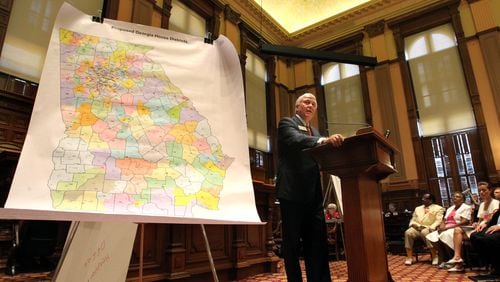A look at the recent election results for Georgia’s 236 legislative seats points to a stark conclusion: Democracy is largely kaput, a pleasant theory, but one no longer in practice.
There are 180 seats in the state House, but just 32 had both a Democrat and a Republican on the ballot. Of the 56 seats in the state Senate, there were 15 active races in the fall.
I say “active” races, but that’s not true. Often, there was merely a warm body with a D or R after his or her name taking space on the ballot, a candidate with no shot in Hades of anything but crashing defeat.
Here's some more numbers for you: those 47 "active" races out of 236 districts translates to a paltry 19.9 percent. The average winner in those contests got 67 percent of the vote. That means that Gov. Nathan Deal and future U.S. Sen. David Perdue, Republicans who both rolled with 52-45 percent margins, were involved in comparative squeakers.
No incumbent legislators lost in the fall, although seven lost in primary challenges earlier in the the summer, five Republicans and two Dems.
Why bother to go through all the expense of general elections? Why not just pack away the polling machines after the July primary runoffs? Redistricting has solidified gains Republicans have achieved in Georgia the past decade, giving the party a two-thirds Super Majority in the Senate and leaving it just one seat shy of achieving that magic number (120 seats) in the House.
The two closest races in the fall were in metro Atlanta — House District 105 in Gwinnett County and House 66, mostly in Douglas County.
Joyce Chandler, the 105th’s one-term Republican, was involved in the closest race of the 236, winning 52.78 percent of the vote to beat Democratic challenger Renita Hamilton.
When told that just 47 of 236 seats had active races and the winner averaged 67 percent, Chandler paused and said, “Oh my,” sounding like the kindly grandmother and retired educator she is.
She decided to run two years ago when the district was formed and was roughly 50-50 Democrat/Republican. “I felt I had as good a chance as anybody with it being 50-50,” she said.
She’s hit on a very important point: With districts less lopsided, more people are likely to run and there’s more likely to be a true contest of ideas. But I’m sounding like one of those U.S. history students Mrs. Chandler once taught years ago.
The district is increasingly “diverse,” she said, meaning “I can’t win by just winning white voters.”
Some 50 miles to the southwest in Douglasville, former state Rep. Bob Snelling thought he could come out of retirement and snatch one away from the Democrats. He knocked on 1,200 doors and his campaign knocked on 1,800 more. However, he was unable to budge Democratic incumbent Rep. Kimberly Alexander, losing 53-47.
Douglas County has seen a huge influx of black residents, and the area was one of the bright spots for Democrats in an otherwise bleak year.
Snelling knows well the impact of redistricting. Back in 2001, Democratic Gov. Roy Barnes and his little sidekick, Bobby Kahn, were getting inventive in creating legislative districts that pitted incumbent Republicans against each other. The Republicans, naturally, were screaming bloody murder. Snelling’s district was carved in with another Republican’s and so he did the honorable thing, walking away to let his younger comrade have the seat.
“Between 2001 and 2011, the technology and sophistication of figuring out how to do this has gotten better,” Snelling said. “The party in control used them to their benefit. I have no problem with that. To the victor goes the spoils.”
Steve Anthony, the chief aide to longtime Democratic Georgia House Speaker Tom Murphy, who was involved in redistricting in the 1980s and 1990s, noted that, increasingly, districts are solidly packed either Republican or Democratic. “That is absolutely no good for lawmaking,” he said. “There is no incentive to compromise. In fact, it makes them go the other way — you have to appeal to your base.”
I asked him (and I know it’s a stupidly idealistic question) if the process would be more fair and representative if an outsider, with no dog in the fight, was to help create district boundaries? Perhaps a Martian?
“The question is who picks the Martian,” said Anthony, now molding minds at Georgia State University. “It’s in the political arena, so it’s political.”
Anthony headed the state’s Democratic Party in the late 1990s when there was still a party to head. He said redistricting has always been political, but the Republicans have locked down the state better than his cohorts ever did.
That just 47 of the 236 seats had challengers seemed low compared to historical levels, he said.
So, I checked. Back in 1998 there were 100 competitive races in the general election. Two years earlier, there were 107. It was a time when Republicans were banging at the gates of the fortress.
In 2004, Glenn Richardson led a takeover of the state House and became the first Republican speaker in over a century. He figures the lack of contested races is due to the increased cost of running for office against entrenched incumbents. He also figures those who did run against incumbents of the opposite party this time, whether they be Democrat or Republican, were either the perennial candidates or political novices who didn’t realize how bad the beating awaiting them would be.
He said that in 2004, there were six districts with nail-biter races, won by a total of 3,500 votes. “If 3,500 people changed their minds, we’d have only gotten only 88,” he said, which would have been short of the 91 needed to win the House.
He believes Georgia’s voters are not all that different philosophically than they were 10 years ago and are 45 percent Democratic, 45 percent Republican and 10 percent swing voters.
But with the current configuration, the 45 percent in the Democratic camp will be looking in from the outside for a good long while.








